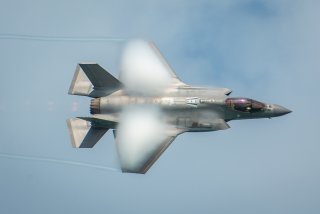F-35 Is Old School: France and Germany Have Big 6th Generation Fighter Dreams
The first FCAS prototypes are expected to fly by 2026.
Here's What You Need to Remember: More than just a plane or series of systems, FCAS has become a crucial next chapter in the emergence of a common European defense industry.
France and Germany have unveiled their much-anticipated Future Combat System (FCAS) at this year’s Paris Air Show, formally entering the global race for a sixth-generation fighter.
FCAS is the successor to aircraft manufacturer Dassault’s four-decade old, fourth-generation Rafale fighter, boasting a bubble canopy design accompanied by what appears to be a fully digitized onboard display. FCAS is significantly larger than its predecessor, but—as with virtually all other fifth and likely sixth generation stealth fighters—will likely only come in a single seat version. Given France’s dedication to a Carrier Strike Group naval doctrine, carrier-compatible FCAS variants are all but guaranteed.
FCAS adheres closely to the information fusion design philosophy of the F-35: “FCAS is more than a combat aircraft. FCAS is a system of systems consolidating a large array of interconnected and interoperable elements: a new generation fighter aircraft, unmanned MALE drones (medium-altitude, long endurance), the current aircraft fleet (which will still be in service after 2040), cruise missiles and drone swarms. The entire system will be connected and operable with a vast perimeter of mission aircrafts, satellites, NATO systems as well as land and naval combat systems. The new generation fighter aircraft will complete and eventually replace the current Rafale and Eurofighters from 2040 onwards,” according to FCAS co-manufacturer Airbus.
France’s upcoming fighter will thus be able to interface with all other satellites and friendly aircraft in the FCAS “air combat cloud,” providing a dynamic, real-time portrait of the battlefield.
It is also clear from this statement, as well as from the accompanying infographics, that the FCAS can direct these “remote carrier” drones to execute a wide range of offensive, recon, and support tasks. Auxiliary drone integration is a popular emerging theme of sixth and late-fifth generation aircraft technology, reportedly present on the successor to China’s J-20 and even on the Su-57.
The Paris Air Show presentation revealed little by way of conventional specifications, instead focusing on the fighter’s “sixth-generation” software capabilities. There is not much room for guesswork when it comes to weapons loadouts, as its lower fuselage is completely obscured in all publicly available photos. It is, however, safe to assume that the fighter will be compatible with nuclear missiles including France’s ASMP and the US B-61-12.
Also, much like the F-35, the FCAS is a joint development project with multiple program partners including Germany and Spain. The participation of the former explains why, as per Airbus’ aforementioned statement, FCAS will be phasing out the Rafale as well as Germany’s Eurofighter by 2040. More than just a plane or series of systems, FCAS has become a crucial next chapter in the emergence of a common European defense industry.
Britain is conspicuously absent from the FCAS program, opting instead to go it alone with its own sixth-generation Tempest fighter to compete with the FCAS while complementing the existing British F-35 fleet. French President Emmanuel Macron indirectly decried Britain’s decision with an appeal to Europe’s common security interests: “Competition amongst Europeans when it weakens us against the Americans, the Chinese, is ridiculous.”
The first FCAS prototypes are expected to fly by 2026.
Mark Episkopos is a frequent contributor to The National Interest and serves as research assistant at the Center for the National Interest. Mark is also a PhD student in History at American University. This article first appeared in June 2019 and is being republished due to reader interest. Image: Reuters

